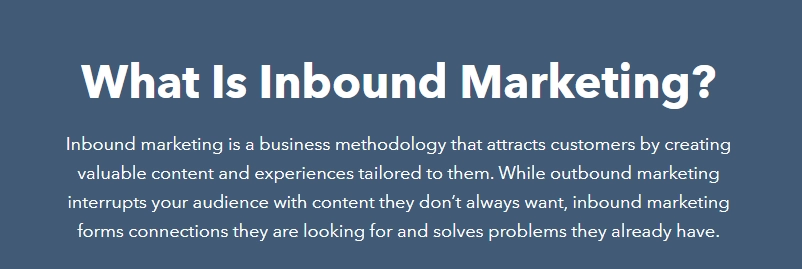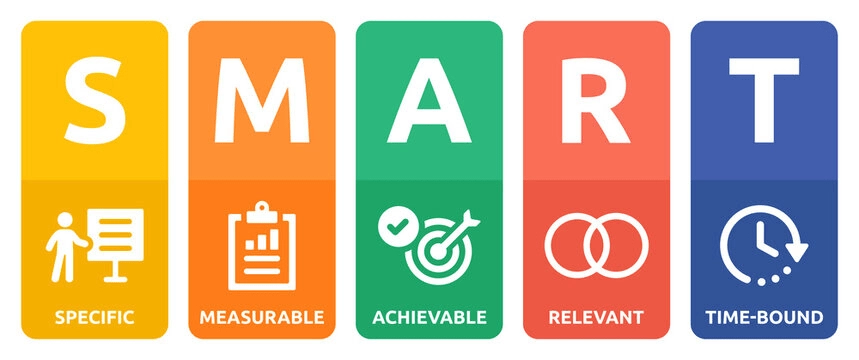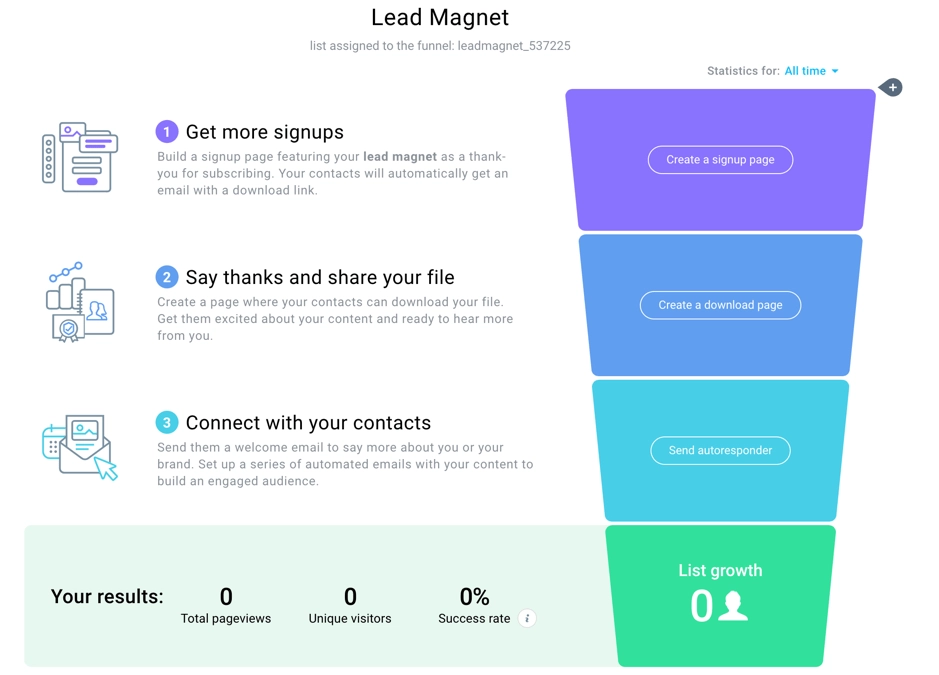We all know how chaotic sales environments can be.
From reps hosting back-to-back discovery calls to managers gathering the team to go over sales metrics and responsibilities, there’s a lot going on. Not to mention the additional long list of to-dos sales managers have to take care of.
Sales managers are like a cross between firefighters, football coaches, and marketers. They’re constantly putting out fires, revving up their team, and taking care of marketing responsibilities, too.
But honestly … it doesn’t have to be this way.
In fact, what if we told you there is something sales managers can employ to both hit their sales targets and manage their responsibilities more efficiently?
It’s called inbound marketing.
In this guide, we’re clearing the air on what inbound marketing is and how it can help sales managers succeed. We’re also sharing six specific inbound marketing strategies that sales managers can start using right away.
Ready?
Let’s begin.
What is Inbound Marketing?
Inbound marketing is a methodology used to attract customers by creating valuable content and personalized experiences.
Instead of using outbound marketing campaigns, which interrupt audiences with content they may not want, inbound marketing focuses on forming connections by solving problems they already have.

In other words, instead of chasing after customers, inbound marketing helps you create opportunities so they can come to you. That means less juggling, less hands-on marketing, and more sales.
Over time, inbound marketing strategies can help you lighten your load and focus on your top priorities.
Inbound marketing typically uses three types of strategies:
1. Attracting strategies: Publishing optimized, relatable, and valuable content to attract customers to your business in your sleep.
2. Engaging strategies: Generating, nurturing, and converting leads using engagement strategies like email marketing, community building, and delivering pristine customer service.
3. Delighting strategies: Nurturing the customer experience throughout the entire buyer’s journey. Strategies may include hosting product demos to top-of-funnel leads (which can be part of a product-led growth methodology), providing post-purchase support, or asking your best customers to join your VIP program.
How can Inbound Marketing Help Sales Managers Succeed?
Inbound marketing helps sales managers succeed by doing the following.
Attracting Customers Rather Than Having to Chase Them Down
Handling a long list of marketing tasks when you already have other responsibilities can feel overwhelming. With inbound marketing strategies, you don’t have to hunt customers down. Customers come to you.
Lightening the Load On Your Sales Team
Your sales team is constantly managing lead lists, performing sales calls, and doing everything they can to hit targets. But expecting sales reps to always be consistent isn’t realistic.
From market variations to changes in audience needs, there are countless factors that can affect a sales rep’s performance. Inbound marketing can help alleviate the burden that comes with heavy sales responsibilities, so your reps can breathe a little easier.
Creating Passive Income in Your Sleep
From generating multiple income streams to making money in your sleep, inbound marketing can help you build an evergreen business model.
Building Trust and Community With Your Audience
Your customers are looking for more than just convenient product features and a great design. They’re looking for a sensational customer experience all the way through. They want to buy from businesses they trust and can engage with easily.
Inbound marketing helps you establish trust by focusing on community-building experiences like delivering personalized content and engaging with your audience.
How to Make the Most Of Inbound Marketing: 6 Strategies
Now that we’ve covered the basics let’s look at six strategies to make the most of inbound marketing.
1. Set Inbound Marketing Goals
Our first strategy is about getting clear on your goals.
When a lead is drawn to your business, what do you want them to do? What specific products do you want them to buy? What kind of content do you want them to consume? What kind of nurturing would help them get closer to conversion?
In this section, get laser-specific about your goals.
Use the template: “specific desire + reason” to help you formulate actionable goals.
For instance:
“We’d like to boost our life insurance sales by 10% so we can exceed our goals every quarter.”
Or:
“We’d like to build deeper and more meaningful connections with our audience. We believe that strong connections can help us build a long-term community of loyal, happy customers.”
The goals you set should be SMART. This has nothing to do with the intelligence level behind them. SMART is an acronym that stands for Specific, Measurable, Achievable, Relevant, and Time-Bound.

After setting concrete goals, keep them at the front of your mind as you implement your inbound marketing strategies. Always ask yourself how inbound marketing can support you on your way to achieving goals.
2. Create a Content Marketing Plan
Creating a content marketing plan is the main way you’ll attract, delight, and engage your leads.
It carries different levels of importance for different niche websites. For example, content marketing for SaaS is essential because in order to become popular, new software usually needs not only advertising but also explaining and clearly presenting its functions to potential users.
Content marketing is so important because it’s one of the only tactics that checks every box on the inbound marketing checklist.
A content marketing plan is how you deliver massive value, implement lead conversion strategies, and build authority with search engines.
When deciding on a plan, we recommend focusing on the following three channels:
- Blogging
- Social media marketing
- Knowledge base creation
Here’s an example of what that might look like:
Blogging
You’ve done heavy keyword research and pinpointed the top keywords you’d like your blog to rank for. Every article on your blog is based on a specific keyword and commonly asked questions. Search engines love your content because it’s actionable, helpful, and based on search intent.
Every article on your blog has a clear intention, call to action, and enticing offer that gently pushes readers toward conversion.
Social media marketing
Your social channels help you connect with your audience in a personal and meaningful way. You take engagement seriously and use social listening tools to spot brand mentions that don’t show up in your notifications.
You tailor your social media content with your audience in mind and always look for ways to deliver value. Over time, you build a tight-knit community of VIP customers, hot leads, and top-of-funnel prospects that are on their way to conversion.
Knowledge base creation
Your knowledge base is full of helpful tips, in-depth guides, product reviews, and tutorials. Your audience can count on you to teach them something, guide them through challenges, or look to you for support.
As a result, your knowledge base content alleviates common customer pain points and helps you establish trust and customer loyalty. There are several AI writing tools that can help you with this.
3. Scale Your Content With Workflow Automation
Content marketing requires time, resources, and a dedicated group of people to see it through.
We recommend implementing workflow automation into your content marketing plan to save time creating tasks, assigning articles to your team, and managing content.
Not only does workflow automation streamline just about every aspect of content marketing, but it’s also a key player in content scalability.
By automating the process, you can make sure you’ll always have a steady stream of content to drip into your marketing channels.
4. Create an Email Marketing Plan
Email marketing is the closest way to have a conversation with your audience without having to jump on a sales call.
Email marketing is a direct marketing channel that can help you:
- Nurture existing customers
- Engage with your audience
- Convert leads into customers
- Market flash sales, offers, discounts, and specials
- Send company updates and recent news
- Get to know your audience better
- Stay top-of-mind
When creating your plan, start by considering your audience. What pain points do they have? What content would best serve them? What do their email consumption habits look like?

Consider dividing your audience into segments to make sure you always deliver the right content to the right people. You can segment your audience by funnel stage, personal preferences, or specific offers they’ve shown interest in. There are several email marketing tools that can help you with this.
Then, create starter campaigns that are aimed at targeting each audience segment.
Finally, don’t forget to build your list. How can you convince leads to subscribe to your emails?
In the next section, we’ll show you how to boost opt-ins using enticing lead magnets.
5. Boost Your Email Opt-Ins With Irresistible Lead Magnets
Now that you know which audience segments you’re targeting and what campaigns to deliver, it’s time to create a strategy for getting more opt-ins.
Our favorite method for boosting opt-ins is using irresistible lead magnets.

In case you haven’t heard the term “lead magnet” before, it simply means giving something away so you can gather contact details.
For instance, you might give a discount, freebie, or a downloadable in exchange for someone signing up for your email list.
Here are some other examples of lead magnets:
- Free consultations
- Giveaways
- Whitepapers
- Ebooks
- Guides
- Courses
- Webinars
- Live streams
- Tester products
As far as where you use lead magnets, there’s a lot of flexibility. You can embed lead magnets into paid ads, blog content, social media content, sales pages, and email content.
You can also embed lead magnets on your website and landing pages too.
6. Establish a Strong LinkedIn Presence
Did you know that conversations on LinkedIn increased by 43% in the first quarter of 2021? That’s right, LinkedIn is becoming a powerhouse for sales teams and marketers alike.
Here are our best tips for establishing a strong presence on LinkedIn:
- Establish credibility by posting consistent thought leadership content
- Commit to only sharing valuable content with actionable takeaways
- Host webinars, courses, and tutorials your audience crave on LinkedIn Learning
- Use direct messaging to form deeper connections
- Use LinkedIn to curate new segmented lead lists
For more tips on how to make the most out of your LinkedIn presence, check out:
- 6 Proven Ways to Expertly Use LinkedIn Live for Your B2B Marketing
- 4 Powerful Ways to Use LinkedIn to Generate Leads
- 6 Experts Advice to Develop an Engaging LinkedIn Content Strategy
Wrapping Up
Sales environments can be chaotic.
The back-to-back sales calls, team meetings, and endless responsibilities are enough to make any team sweat. Not to mention the additional tasks sales managers have to keep up with, too.
But with inbound marketing, everything can change.
Your entire team can breathe a little easier. You can smile as you watch increasingly more leads show up in your inbox. And remember that passive income stream we touched on earlier? It can all be yours with inbound marketing.
To review, the six examples set in this article include:
- Setting SMART inbound marketing goals that you can constantly be working toward
- Creating a winning content marketing plan that has every step of the process covered
- Scaling your content with workflow automation can take some of the burden off your team.
- Creating a winning email marketing plan that takes audience segmentation into account.
- Using lead magnets within your emails to greatly improve your odds of conversion
- Establish a strong presence on LinkedIn to network freely and demonstrate your expertise through relevant shared content.
Ready to boost sales with inbound marketing? Leave a comment below, letting us know which strategy you’re eager to try out first.
___
Shane Barker is a digital marketing consultant who specializes in influencer marketing, content marketing, and SEO. He is also the co-founder and CEO of Content Solutions, a digital marketing agency. He has consulted with Fortune 500 companies, influencers with digital products, and a number of A-List celebrities.

